The new 224 Valkyrie has a cool name and is getting lots of publicity these days, but do you really need one?
Many hunters likely don’t know much about the .224 Valkyrie. This is perfectly understandable because it’s a relatively new cartridge and Federal didn’t officially unveil it until the 2018 SHOT Show. Even so, the 224 Valkyrie has received a lot of coverage in the media and is extremely popular in some circles.
Not surprisingly, while some people absolutely love the cartridge (and we’ll discuss why in a minute), others are skeptical that the .224 Valkyrie is either the latest flavor of the week or the answer to a non-existent problem.
In this article, I’m going to cut through the hype in order to discuss the strengths and weaknesses of the .224 Valkyrie cartridge in detail. I’ll also provide some information on how it stacks up next to the .223 Remington and 22 Nosler cartridges so you can decide if it fits your needs as a hunter.
Before we get started, I have two administrative notes:
Some of the links below are affiliate links. This means I will earn a small commission (at no extra cost to you) if you make a purchase or rifle, handgun, shotgun, or rimfire ammunition. This helps support the blog and allows me to continue to create free content that’s useful to hunters like yourself. Thanks for your support.
Finally, I recorded an entire podcast episode on the .224 Valkyrie. If you’d rather listen than read, you can either just press play below or click the appropriate link to download the episode through your preferred service.
Subscribe
Apple | Google | iHeart | Pandora | Spotify
224 Valkyrie: History
Interest in long range precision shooting has seen a tremendous amount of growth in the past few years. At the same time, the popularity of AR-15 style rifles has dramatically increased among American hunters and shooters as well. Not surprisingly, the big ammunition and rifle manufacturers have developed a number of new products in order to satisfy this emerging new market desiring long range precision capabilities in an AR-15 platform.
Nosler rolled out their proprietary 22 Nosler cartridge back in 2017 in an effort to improve upon the performance of the old .223 Remington cartridge, especially at extended range. The Nosler cartridge has a greater case capacity than the .223 Remington and therefore offered a substantial increase in performance compared to the older Remington cartridge while still functioning reliably in a standard AR-15 style rifle.
The designers at Nosler were largely successful in achieving their goals. Even so, initial 22 Nosler offerings used bullets that topped out around the 77 grain mark, which is also about as heavy as you’ll commonly find bullets used in .223 Remington factory ammo.
So, while the 22 Nosler could shoot those bullets 200-300 fps faster than the .223 (which isn’t nothing), that was basically the extent of the performance improvements of the 22 Nosler vs the 223 Remington at first.
Well, Federal decided to build another cartridge with a similar goal as the 22 Nosler.
However, they set out from the very beginning to build a cartridge that was also capable of using longer, heavier, and more aerodynamic bullets. They formally introduced the resulting 224 Valkyrie cartridge to the world in 2018 about a year after Nosler released the 22 Nosler.
The 224 Valkyrie uses a modified 6.8 Remington SPC case (which is itself a modified .30 Remington case) necked down to .22 caliber. Most importantly though, the cartridge was specifically designed around a 90 grain Sierra MatchKing bullet (SMK) from the start. For that reason, most rifles chambered in .224 Valkyrie have a pretty fast 1:7″ rifling twist rate.
One of Federal’s initial 224 Valkyrie loads fired that 90 grain, high BC projectile at 2,700 fps, which was absolutely unheard of performance from a .22 caliber rifle cartridge that would fit in an AR-15 platform at the time.
Compared to other cartridges commonly used in AR-15 style rifles, those long, sleek Sierra MatchKing bullets retain energy exceptionally well, are very resistant to wind drift, and have a very flat trajectory at long range. Indeed, Federal advertises that load as being supersonic out past 1,300 yards and touts the cartridge as an excellent option for engaging targets in excess of 1,000 yards.
To top it all off, the cartridge does all of those things while generating very little recoil.
Federal also really helped out their marketing and promotional efforts with their name choice for the cartridge. Valkyries are female figures in Norse mythology that choose who will die in battle and then take their chosen ones to the Valhalla.
As you can probably imagine, there’s been a bunch of buzz around the 224 Valkyrie cartridge from the very start and it does offer some pretty good benefits to hunters and shooters.
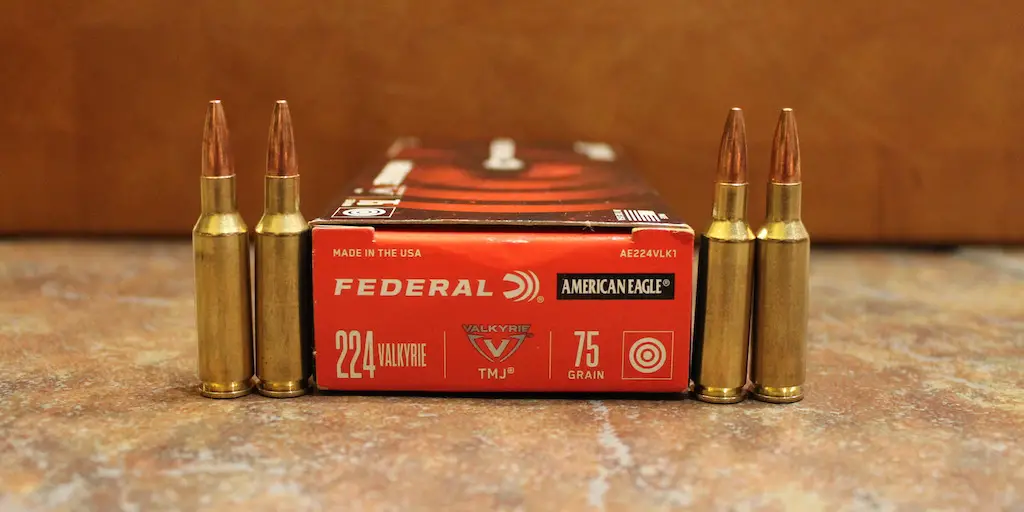
For instance, the cartridge is an interesting choice for Precision Rifle Series competition (PRS) shooting, particularly in the gas gun series.
During PRS competitions, shooters must quickly engage targets at a variety of ranges out past 1,000 yards. The competition is timed, so first round hits are ideal, but there’s more to performing well at these competitions than just shooting small shot groups. The ability to make rapid follow up shots and quickly correct for misses is also extremely important, especially in windy conditions.
Shooters also cannot use bullets larger than .308″ or with a velocity higher than 3,200 feet per second. For those reasons, high velocity (up to a point), flat shooting, medium bore, and mild recoiling cartridges with a long barrel life have a big advantage in these competitions.
Cartridges like the 6mm Creedmoor, 6mm Dasher, 6x47mm Lapua, 6XC, 6.5 Creedmoor, and 6.5×47 Lapua all have substantial advantages over the 224 Valkyrie in terms of trajectory and resistance to wind drift. Not surprisingly, they’re all much more popular at PRS competitions.
Even so, the ability of the 224 Valkyrie to use those really aerodynamic bullets with very minimal recoil (which can help facilitate a rapid follow up shot) makes it a compelling choice for some shooters. This is especially true for those shooting in the gas gun series open division who prefer a .22 caliber cartridge.
While the 224 Valkyrie was designed primarily to offer improved performance at long range for shooters who want to use a .22 caliber cartridge in an AR-15, it does offer advantages to hunters as well.
For instance, in addition to manufacturing their Gold Medal line of ammunition featuring the aforementioned 90 grain Sierra MatchKing bullet, Federal Premium also offers a load in their Fusion MSR line loaded with a 90 grain Fusion Soft Point bullet. Though using a .22 caliber cartridge for hunting deer sized game (especially with lighter bullets) is still a somewhat controversial subject, that 90 grain load is one of the better options out there.
Federal also manufactures a couple of varmint loads in the cartridge as well. These loads also offer a modest improvement in performance over the .223 Remington for predator and varmint hunting.
At this point, American Eagle, Federal ammunition, Hornady, and Underwood all manufacture 224 Valkyrie factory ammo. At the same time, CMMG, Diamondback, Mossberg, Radical Firearms, Stag Arms, and Savage Arms (among others) all currently produce rifles chambered in 224 Valkyrie. In particular, the Savage MSR 15 is the poster child for an AR-15 style rifle chambered in 224 Valkyrie.
224 Valkyrie vs 223
The 224 Valkyrie is capable of shooting heavier and more aerodynamic bullets than the 223 Remington. Therefore, the 224 Valkyrie has a flatter trajectory, less wind drift, and more retained energy than the 223 Remington at long range when using very high BC 90 grain bullets.
That’s how the 224 Valkyrie compares to the .223 Remington in a nutshell. However, as we drill down into the details of their similarities and differences though, several factors emerge that are important to keep in mind. This is especially important when we throw the 22 Nosler into the mix as well.
223 vs 224 Valkyrie vs 22 Nosler
The three cartridges have several things in common. First, they all shoot .224″ bullets. Additionally, all three have the same SAAMI maximum pressure of 55,000. Finally, all three have the same maximum overall length of 2.26″, which means they’ll fit in an AR-15.
On the other hand, the .224 Valkyrie has a shorter case length than the .223 Remington and 22 Nosler, which helps explain why the .224 Valkyrie can shoot longer bullets than the other two, but still has the same maximum overall length.
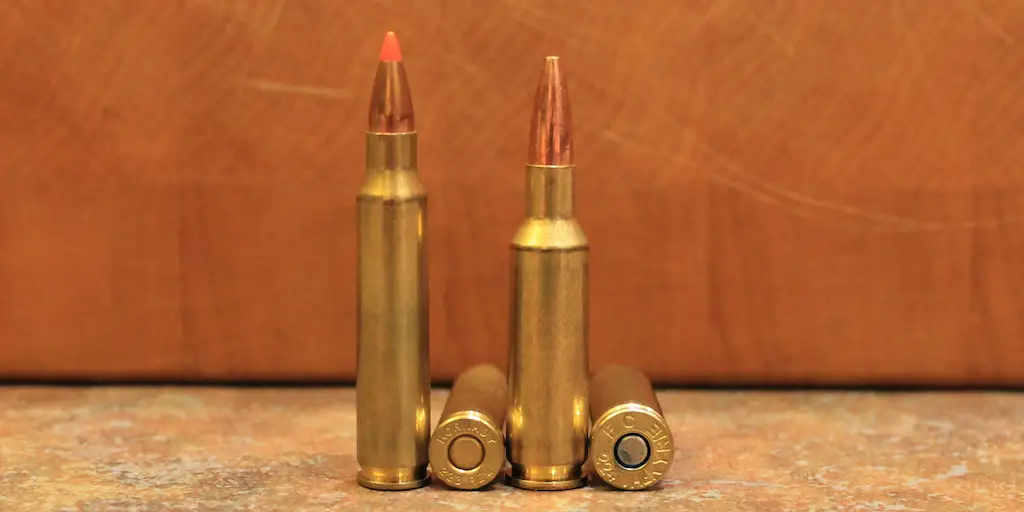
At the same time, like the 6.8 Remington SPC, the .224 Valkyrie has a rim diameter of .422″. Though the .223 Remington and 22 Nosler both have a .378″ rim diameter, the .223 Remington is a rimless case while the 22 Nosler has a rebated rim.
The .223 Remington has a 23 degree shoulder while the .224 Valkyrie and 22 Nosler both have a steeper 30 degree shoulder.
Finally, the 22 Nosler has the most capacity of the bunch, followed by the .223 Remington and finally the 224 Valkyrie.
Note: while the powder capacity figures listed below do give a good indication of the differences between the two cartridges, exact case capacities vary slightly according to the brand of brass used.
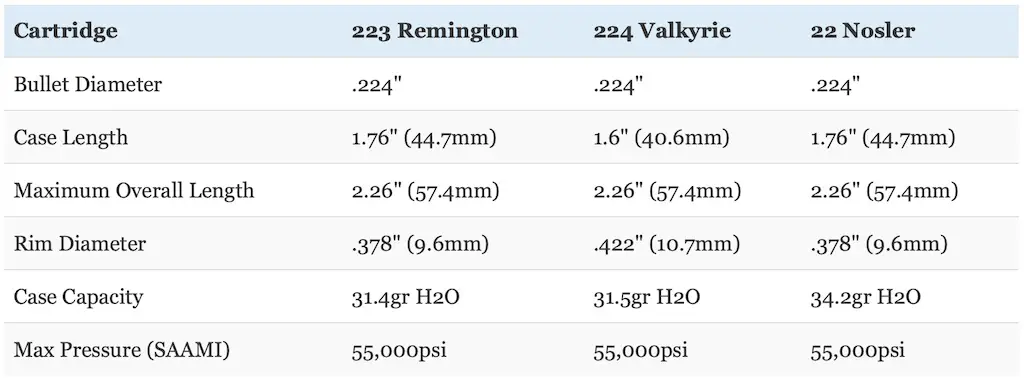
All three cartridges are readily available with bullets in the 50-62 grain range.
That being said, most .223 Remington loads top out at 77 grains. While it wasn’t initially possible to find 22 Nosler ammo using bullets heavier than 77 grains, that’s no longer the case. The company now manufactures 22 Nosler ammo using their extremely aerodynamic 85 grain Reduced Drag Factor (RDF) bullet. On the other hand, 90 grain bullets are very common for the 224 Valkyrie and have been available from the beginning.
That’s really the biggest factor that sets the .224 Valkyrie apart from the other two cartridges: the .224 Valkyrie was designed from the beginning to use the longest and heaviest bullets possible without sacrificing case capacity and while still functioning in semi-automatic rifles like the AR-15 as well as bolt action rifles. The cartridge also has a relatively long neck, which is also an asset when using those long, streamlined bullets.
For these reasons, heavy for caliber bullets will fit in the magazine, reliably chamber, and shoot accurately in 224 Valkyrie rifles.
In that same vein, those rifles also typically have a relatively fast rifling twist in order to ensure that they’ll accurately shoot heavier bullets with a high ballistic coefficient.
Most .224 Valkyrie rifles have a fast 1:7″ rifling twist rate. A slower 1:8″ twist rate is pretty common with the 22 Nosler. 1:8″ and even 1:9″ twist rates are fairly common with the .223 Remington. Though it’s certainly possible to find rifles chambered in .223 Remington/5.56 NATO that have a 1:7″ twist barrel (I even own one), that cartridge is simply not built in a manner that results in optimal performance with bullets heavier than 80 grains.
While all three cartridges are known for their exceptional accuracy (sub-MOA in the right hands), the 224 Valkyrie cartridge in particular is better suited to use high BC and high SD, heavy for caliber match grade hunting bullets than the .223 Remington because of the aforementioned differences in cartridge design and faster rifling twist in rifles chambered for that cartridge.
The table below compares 55gr Nosler Ballistic Tip Varmint (.266 BC) and 62gr Federal Fusion Soft Point (.310 BC) loads in .223 Remington, 60gr Nosler Ballistic Tip Varmint (.270 BC) and 90gr Federal Fusion Soft Point (.424 BC) loads in .224 Valkyrie, and 55gr Nosler Ballistic Tip Varmint (.266 BC) and 70gr Nosler AccuBond (.370 BC) loads in 22 Nosler. This data is for Nosler Trophy Grade, Nosler Varmint, Federal Fusion MSR, and Federal V-Shok factory ammo using a 200 yard zero.
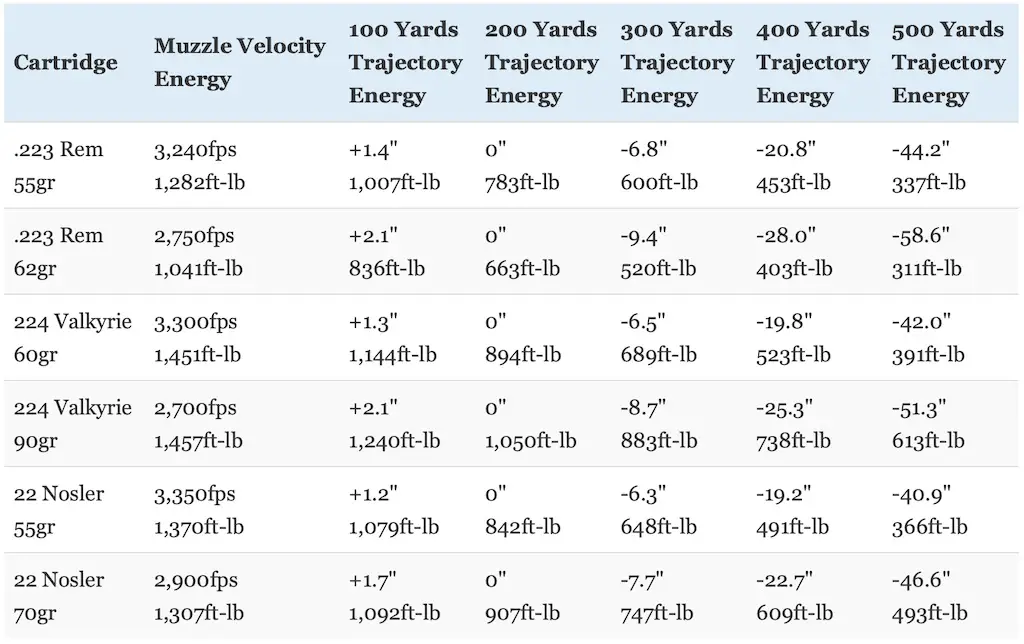
As you can see, all three cartridges have a very similar trajectory with the lighter 55gr and 60gr varmint loads. The .223 Remington load has about 10% more bullet drop than the 22 Nosler at 500 yards and the 224 Valkyrie load has about 30 ft-lbs (about 7%) more kinetic energy than the 22 Nosler.
On the other hand, while the 22 Nosler still has the flattest trajectory of the bunch with the heavier big game load, the .224 Valkyrie has an even bigger advantage in retained energy. The Valkyrie cartridge has about 11% more energy at the muzzle and about 24% more energy remaining at 500 yards than the 22 Nosler.
It’s unlikely that any animal will be able to tell the difference between an additional 100-200 ft-lbs of energy with a well placed bullet, but especially when using a .22 caliber cartridge on deer sized game, every little bit helps.
All that being said, I’m not advocating shooting any big game animal at 500 yards with either cartridge. If you subscribe to the theory that 1,000 foot pounds of energy is a good minimum rule of thumb for hunting deer, then that 90 grain .224 Valkyrie load is acceptable for deer out just past 225 yards while the .223 Remington and 22 Nosler loads fall below that threshold inside 25 yards and just shy of 150 yards respectively.
Since this article is focused on the performance of these cartridges for hunting, I didn’t include any ballistic data past 500 yards in the table above. However, that’s really where the 22 Nosler and 224 Valkyrie really pull away from the .223 Remington in terms of trajectory and wind drift when using high bc target ammo.
To further illustrate that same point, consider the supersonic ranges of the three cartridges. The details vary depending on the exact load, but there are loads for both the 22 Nosler and 224 Valkyrie that stay supersonic out well past 1,000 yards. The .223 Remington on the other hand normally crosses the sound barrier before it travels 800 yards.
The chart below compares how much a 10 mile per hour crosswind impacts those same loads for each cartridge out to 500 yards.
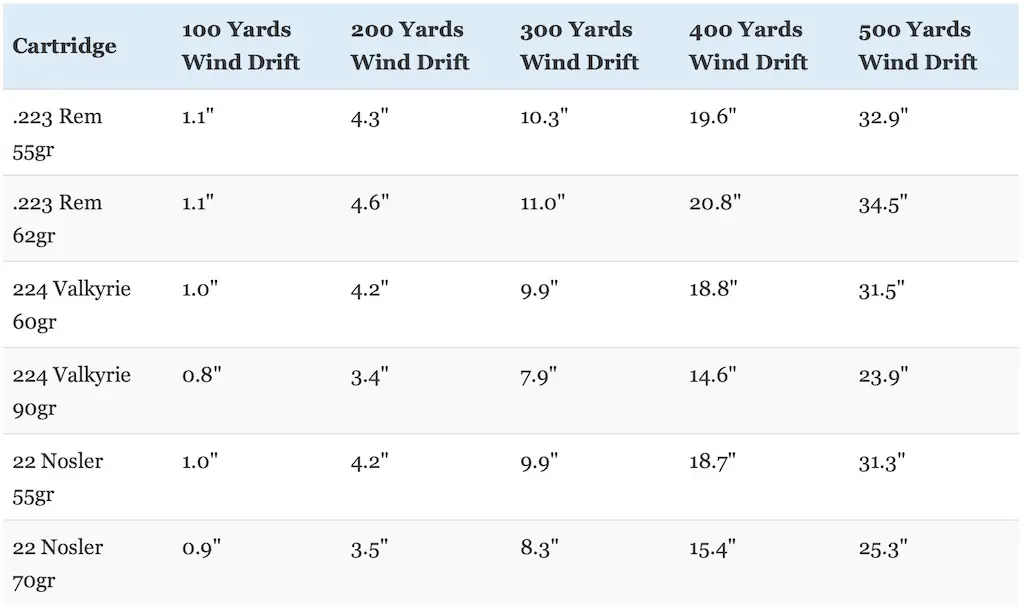
There’s virtually no difference in wind drift between the lighter varmint bullets in the three cartridges: just .2″ of separation between the .224 Valkyrie and the 22 Nosler and 1.6″ between the .223 Remington and 22 Nosler at 500 yards.
There is a little bit more difference when talking about the heavier bullets though. The 62gr .223 Remington load drifts about 10% more than the lighter .223 Remington load, but the 70gr and 90gr 22 Nosler and 224 Valkyrie loads are much more resistant to wind drift than the varmint loads for those cartridges.
In that situation, the superior ballistic coefficient of the 90 grain bullets used by the 224 Valkyrie help give it a significant advantage over the other two cartridge as the range increases. That particular load drifts about 23.9″ at 500 yards, which is about 1.4″ less than the 70 grain 22 Nosler load and about 10″ less than the heavier .223 Remington load.
All of these cartridges have an extremely mild recoil that most shooters and hunters should be able to handle.
Don’t underestimate the impact that recoil has on the ability of a person to shoot accurately either. Regardless of how well a given person handles recoil, all other things being equal, they will absolutely shoot better with a milder recoil, which is very similar for all three cartridges. A mild recoil also facilitates with spotting misses and taking a rapid follow up shot both at the range and afield.
This is a big plus in favor of the 22 Nosler and .224 Valkyrie since they do offer improved performance compared to the .223 Remington with very little additional recoil.
As far as ammunition and rifle availability go, the .223 Remington wins hands down.
It’s probably one of the top 5 most popular centerfire rifle cartridges in the United States, so there is an incredible variety of ammo and rifles to choose from. Basically every sporting goods store will have a good selection of reasonably priced .223 Remington ammo and rifles.
This is especially true when it comes to low cost ammo for practicing and plinking. It’s possible to find FMJ or TMJ ammo for the other two cartridges that’s not as expensive as the premium stuff, but it will still probably cost about twice as much as similar quality ammo for the .223 Remington. On the other hand, the .224 Valkyrie and .22 Nosler generally offer better ammunition options for big game hunting than the .223 Remington.
Neither the 22 Nosler nor the 224 Valkyrie is really rare, but they can’t hold a candle to the .223 Remington in that regard though. The 22 Nosler is a proprietary cartridge, so there’s a limited selection of both loaded ammunition and even brass for reloading. Since the cartridge uses a completely new case, it’s not even possible to form .22 Nosler brass from a different cartridge case.
The 224 Valkyrie is a little more common than the .22 Nosler, but there’s still a relatively limited selection of Valkyrie ammo. At this point, American Eagle, Federal, and Hornady are the main sources of .224 Valkyrie factory ammo. Unlike the .22 Nosler, reloaders can form 224 Valkyrie brass from 6.8 SPC brass. That being said, we’re not exactly swimming in that 6.8 SPC brass either, especially compared to the .223 Remington.
Additionally, since the cartridge was made from 6.8 SPC brass, it has a larger case diameter than the .223 Remington, which necessitates the use of a larger bolt face than the other two cartridges.
Finally, though the .22 Nosler and .224 Valkyrie will work with a standard AR-15 style rifle, they require the use of 6.8 SPC magazines.
So where do we stand overall with the .223 Remington, 224 Valkyrie, and 22 Nosler?
The .223 Remington is an extremely common cartridge and hunters who want to use it have abundant supplies of quality rifles (both semi-autos and bolt guns) and ammunition. The cartridge has an extremely mild recoil and is capable of excellent accuracy. That said, the .223 Remington has the most arching trajectory, retains the least energy as it travels downrange, and has the least resistance to wind resistance out of the group.
The .22 Nosler offers a noticeable improvement in ballistics when compared to the .223 Remington. This is primarily due to the fact that it has a larger case capacity and is also capable of shooting the same weight bullet 200-300 fps faster than the .223 Remington.
Nosler has also recently expanded their line of .22 Nosler ammunition to include a good big game option with the 70 grain AccuBond as well as an improved long range shooting option with the 85 gain RDF. Both of these developments have eaten into the edge previously enjoyed by the .224 Valkyrie. .22 Nosler ammunition and rifles are not as easy to find or a reasonably priced as .223 Remington ammo though.
The .224 Valkyrie also offers a sizable improvement in performance over the .223 Remington, especially for very long range shooting. This is primarily due to the fact that the cartridge was specifically designed to use very heavy, long, and aerodynamic bullets.
While performance at extreme long range is less important for hunters than for target shooters, the .224 Valkyrie is still a noteworthy choice for big game hunters in particular because it can effectively use 90 grain bullets. If you wanted to use a .22 caliber AR-15 for deer hunting, I’d recommend going with the .224 Valkyrie and using either that 90 grain Federal Fusion load or the load below featuring a 78 grain Barnes TSX.
If it sounds like I’m splitting hairs here, it’s because I am.
All things considered, the differences between these cartridges are very small and, while there are real differences between the .223 Remington, .224 Valkyrie, and .22 Nosler, it’s almost all at the margins.
Best 224 Valkyrie Ammo For Hunting
Due in part to the fact that the cartridge is relatively new, there aren’t many options for factory .224 Valkyrie hunting ammo right now. There are currently only a few options for loaded rifle ammunition, but that list is slowly growing and there are a few pretty good options for both big game and varmint hunting.
Update July 2021: Ammo supplies finally look like they’re starting to recover. We still have a long way to go and selection is still nowhere near where it was back in 2019, but things are a lot better now than they were even 6 months ago.
Click the link below if you just want to quickly check what ammo is in-stock and ready to ship so you can hit the range and get ready for hunting season.
GET IN-STOCK 224 VALKYRIE AMMO HERE
Federal Fusion
One of the biggest strengths of the .224 Valkyrie is the ability of the cartridge to effectively use 90 grain bullets and still function reliably in an AR platform. In addition to manufacturing ammo suitable for long range shooting, Federal also opted to manufacture a line of ammunition for that cartridge suitable for big game hunting that still functions well in a modern sporting rifle.
Using a 90 grain soft point bullet, this particular .224 Valkyrie ammunition is specifically designed for use on big game like deer and feral hogs. Engineered for rapid expansion at a wide range of impact velocities, this ammo uses bullets with a lead core chemically fused to the jacket to minimize the chances of core-jacket separation. All in all, this is outstanding 224 Valkyrie ammo for hunting medium game like deer, pronghorn, and feral hogs with a Modern Sporting Rifle.
- Bullet Type: Federal Fusion Soft Point
- Bullet Weight: 90 grains
- Ballistic Coefficient (BC): .424 (G1)
- Muzzle Velocity: 2,700 feet per second (1,457 ft-lbs of muzzle energy)
GET FUSION 224 VALKYRIE AMMO HERE
Also Available At: Brownells, Lucky Gunner, & MidwayUSA
Nosler Ballistic Tip Varmint
The .224 Valkyrie is also a great varmint and predator hunting cartridge. Loaded with a 60 grain Nosler Ballistic Tip Varmint bullet at a blazing 3,300fps, this load is great for hunters who want a really fast expanding bullet that rapidly delivers a tremendous amount of energy to game. If that sounds like what you want, then strongly consider using this ammunition for coyote, bobcat, and prairie dog hunting.
- Bullet Type: Ballistic Tip Varmint
- Bullet Weight: 60 grains
- Ballistic Coefficient (BC): .280 (G1)
- Muzzle Velocity: 3,300 feet per second (1,451 ft-lbs of muzzle energy)
GET BALLISTIC TIP 224 VALKYRIE AMMO HERE
Also Available At: Federal Premium, Lucky Gunner, & MidwayUSA
Barnes Triple Shock-X
Federal Premium also produces .224 Valkyrie ammo featuring the Barnes Triple Shock-X (TSX) bullet. This is another outstanding choice for hog or deer hunting with the 224 Valkyrie. There’s not much that I can say about the Barnes TSX that hasn’t already been said and this copper hollow point bullet is well known as one of the best choices around for big game hunting.
So, if the 90 grain Federal Fusion ammo isn’t really your cup of tea and you prefer something with even more controlled expansion and higher weight retention, or if you need to use lead free ammo, then this ammo loaded with their 78gr TSX bullet is perfect for you. Like the 90gr Fusion load, this is also great .224 Valkyrie ammo for deer hunting.
- Bullet Type: Barnes TSX
- Bullet Weight: 78 grains
- Ballistic Coefficient (BC): .383 (G1)
- Muzzle Velocity: 2,850 feet per second (1,407 ft-lbs of muzzle energy)
GET BARNES 224 VALKYRIE AMMO HERE
Also Available At: Federal Premium, Lucky Gunner, & MidwayUSA
Hornady Varmint Express
Like the .223 Remington, the .224 Valkyrie is also a really good varmint cartridge. For that reason, Hornady offers the .224 Valkyrie as part of their Varmint Express line of ammo. Loaded with a 60 grain V-Max bullet at 3,300 feet per second, this is a very accurate and extremely flat shooting varmint hunting load at all practical ranges. These high velocity, rapidly expanding bullets aren’t really suitable for big game hunting, but they’re absolutely devastating on varmints and predators.
- Bullet Type: Hornady V-MAX
- Bullet Weight: 60 grains
- Ballistic Coefficient (BC): .265 (G1)
- Muzzle Velocity: 3,300 feet per second (1,451 ft-lbs of muzzle energy)
GET HORNADY 224 VALKYRIE AMMO HERE
Buy Now At: Brownells, Lucky Gunner, & MidwayUSA
Final Thoughts On The 224 Valkyrie
The .224 Valkyrie is a very well designed cartridge that offers marginal advantages over similar cartridges like the .223 Remington and .22 Nosler. While it does provide undeniable advantages in certain areas (like extreme long range shooting), the small benefits it offers over more established calibers like the .223 Remington probably aren’t significant enough to justify making the switch for most hunters.
All things considered, the .223 Remington is a darn good cartridge itself and it’s a whole lot easier to get good quality, reasonably priced rifles and ammo for.
This is particularly true for varmint and predator hunters. Yes, the .224 Valkyrie shoots a tiny bit flatter, drifts a little less in a crosswind, and hits a little harder, but it’s not a dramatic difference between them. That being said, the ability of the Valkyrie to effectively use those 78gr TSX and 90gr Fusion bullets are more sizable advantages for big game hunters.
Even so, I’m not sure that is a big enough reason for most hunters to transition over to the .224 Valkyrie on its own. If those traits are important to you, then by all means make the switch.
Now if you’re into long range shooting and you want to also use that cartridge for a little hunting on the side, then the .224 Valkyrie makes a whole lot more sense. At the same time, if you’re the type of person who wants to wring out all the performance you can from a certain caliber, then by all means get a .224 Valkyrie. It’s a fantastic little cartridge and I’m sure it will serve you well afield.
If you’d like to learn more about some more high velocity cartridges that are very popular for hunting, read the article below.
22-250 vs 224 vs 204 Ruger vs 220 Swift: Clash Of the Speed Demons
Enjoy this article about the 224 Valkyrie? Please share it with your friends on Facebook and Twitter.
John Snow’s article for Outdoor Life was used as a reference for the history of the 224 Valkyrie. The Hornady 10th Edition (p160-168), reloading manual was also used as a reference for the history of the cartridges and provided data to compare their size and recoil. Nosler provided the data used to compare the recoil of the .243 Winchester (here). Chuck Hawks (here), the American Rifleman (here), and Nosler (here) provided the case capacity for each cartridge. The data used to compare the trajectory of the cartridges was obtained from Nosler (here and here) and Federal (here, here, here, and here). Maximum pressure obtained from SAAMI (p26 for the .223, here for the 224 Valkyrie, and here for the 22 Nosler). I used the Hornady Ballistic calculator and Shooters Calculator to compare wind drift, the range each bullet goes subsonic, and recoil for the cartridges.
Make sure you subscribe to The Big Game Hunting Podcast and follow The Big Game Hunting Blog on Facebook, Instagram, Twitter, and YouTube.
NEXT: 6.5 GRENDEL VS 6.5 CREEDMOOR: WHICH IS RIGHT FOR YOU
John McAdams is a proficient blogger, experienced shooter, and long time hunter who has pursued big game in 8 different countries on 3 separate continents. John graduated from the United States Military Academy at West Point and is a veteran of combat tours with the US Army in Iraq & Afghanistan. In addition to founding and writing for The Big Game Hunting Blog, John has written for outdoor publications like Bear Hunting Magazine, The Texas State Rifle Association newsletter, Texas Wildlife Magazine, & Wide Open Spaces. Learn more about John here, read some of John’s most popular articles, and be sure to subscribe to his show: the Big Game Hunting Podcast.

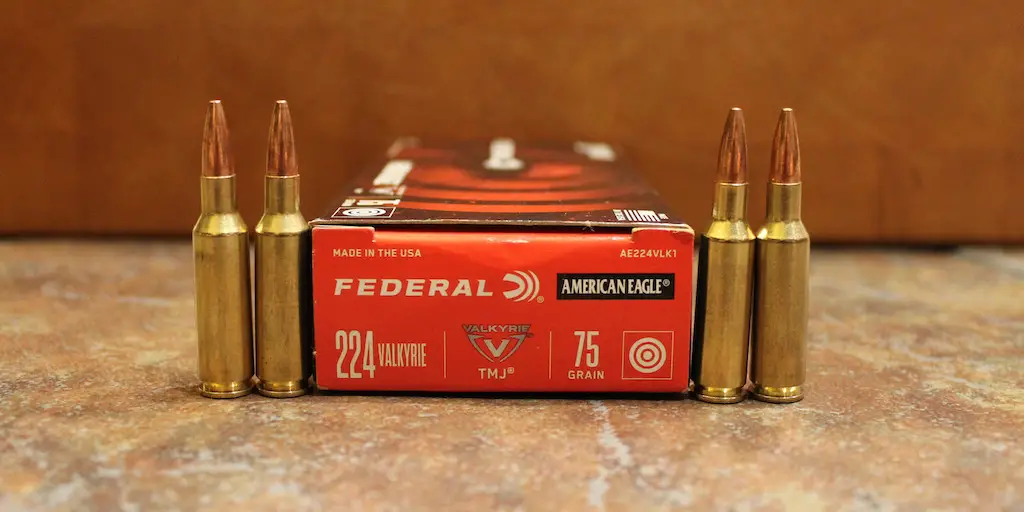

In my opinion I think the 5.56/223 cartridge, still has allot to offer. Giving that an ammunition manufacturer would do the R&D,What I am getting at is, that with all of the newer modern advancement in propellants, projectiles, and case technology, such as the bimetal case that Sig Sauer uses on their new 6.8×5/277fury cartridge. Why not apply that same bimetal case technology, slightly raising the pressure of the 5.56/223 cartridge. in theory it should improve 5.56/223 cartridge well beyond any other cartridge in its class, so that it can use heavier projectiles, travels faster, hits harder, and improves the range…
Swap the bbl and bolt on a ruger sfar , open the front of the mag , use ar10 pmag body as adapter…load out to 2.5″coal . ..60ksi vs 55ksi .